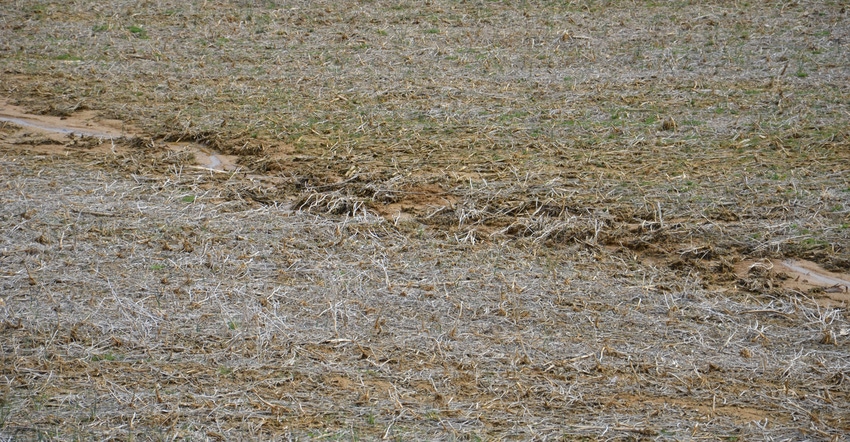
Most Indiana winters involve fluctuating weather conditions. Cold weather is followed by a warmup and rain. Then it freezes again, and then warms up and rains. This has certainly been the case this winter. How do fluctuating weather condition affect your soils?
Don Donovan, district conservationist with the Natural Resources Conservation Service, Parke County, Ind., says soils expand and contract as they freeze and thaw, and can become more “loose” — which is related to the tilth of your soil. This can help with compaction issues.
But when the most productive 1 to 2 inches of the soil thaws and is “loosened” above frozen soil, those top inches are vulnerable to pounding rain and can even leave your farm through runoff. Even if your farm is flat, you may see the impacts of winter erosion as sediment deposits throughout your field.
Shannon Zezula, state resource conservationist with NRCS, says farmers who don’t use tillage and do plant cover crops are taking care of their soil. Crop residues and cover crops work together to moderate extreme air temperature swings, and protect the soil when winter rains come. Even when the top inches of the soil thaw, plant residues and roots maximize the chance that valuable topsoil will stay in place.
As you get ready for planting, do some early scouting. Do you see areas of erosion? Some of the worst cases of gully erosion happen when intense rains pound semifrozen ground, many times eroding all the way down to the freeze line. Often these eroded areas are just a precursor to additional erosion later in the growing season. Once these eroded areas get started, they’re hard to stop.
How did your soils fare this winter, and how prepared are they for this spring’s rains? What can you do differently in 2018 to prevent such erosion from occurring again? Contact your local NRCS office to start planning now for the winter of 2018, Donovan says.
Cover crop lessons
As you drive Indiana roadways this spring, take note of the lush, green growth in many fields. It’s likely you won't have to drive far to find cover crops, because Indiana farmers are national leaders in planting them.
These cover crops do many things for the soil, including erosion control, nutrient scavenging, increasing soil organic matter and alleviating compaction, Donovan says. During the growing season, cover crop residue will again provide erosion protection while helping control weeds, maintain moisture in the soil surface and keep the soil temperature from getting too hot.
Why does Indiana have so many cover crop acres? Zezula says it’s because Hoosiers are willing to share their experiences with other farmers and conservation professionals. These farmers have learned about the benefits of soil health through trial and error, working alongside conservation professionals eager to help others get a jump-start on soil health management. Many agriculture retailers, seed suppliers and consultants are willing to help you on your journey to improved soil health, Zezula adds.
A great place to start is to talk to your neighbors who have experience with these systems, he says. Watch for workshops or field days where you can learn about how these systems can help your farm. Check out the Conservation Cropping Systems Initiative website for upcoming events.
About the Author(s)
You May Also Like




